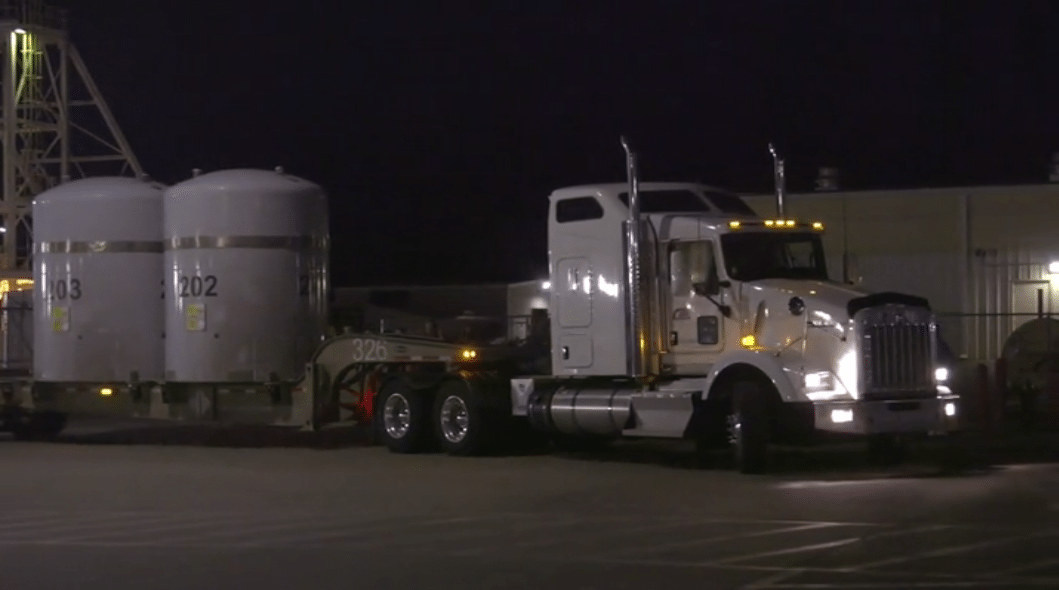
For the first time in three years, the Energy Department has sent shipments of transuranic waste to the Waste Isolation Pilot Plant (WIPP) in New Mexico for permanent disposal.
Shipments from separate DOE facilities either arrived at WIPP or departed for it this week. One shipment arrived early Monday from the Idaho National Laboratory, while another left the Savannah River Site in South Carolina on Wednesday, according to separate DOE press releases.
WIPP is some 1,200 miles southeast by road from the Idaho Site, and about 1,450 miles west of the Savannah River Site. DOE did not say exactly what sort of transuranic waste the shipments contained, or which legacy weapons program generated the waste.
Department spokespersons declined to answer questions about the shipments, citing security concerns.
The local Idaho Post Register newspaper reported the shipment from that state left on April 6 and contained 4 cubic meters of material.
There are 14,000 cubic meters of contact-handled transuranic waste at DOE’s Idaho site, the department says. That waste is projected to take up about 22,000 cubic meters of space once packaged in containers for permanent disposal at WIPP, according to the agency’s 2016 Annual Transuranic Waste Inventory Report.
The same report says the Savannah River Site’s contact-handled transuranic waste — waste safe enough for properly protected human beings to handle — will take up just under 750 cubic meters after it is packaged for final disposal at WIPP.
WIPP closed for almost three years after a radiation leak and earlier, unrelated underground fire in February 2014. The mine reopened in December but could not accept new shipments until WIPP prime contractor Nuclear Waste Partnership buried waste marooned above ground at the site’s Waste Handling Building after the accidents.
DOE expects to send about 130 transuranic waste shipments to WIPP through January. The next site to send waste that has not already shipped to WIPP this year will be privately owned Waste Control Specialists in Andrews County, Texas, according to the pecking order DOE described at an industry conference in March.
Later this year, the Los Alamos National Laboratory in Los Alamos, N.M., and the Oak Ridge National Laboratory near Oak Ridge, Tenn., will begin shipping their transuranic waste to WIPP, DOE has said.
The department plans at the start to send two shipments a week to WIPP, ramping up to as many as four shipments weekly by the end of the year. WIPP was designed to accept about 15 shipments per week, but the agency does not expect mine personnel to resume that level of throughput for several years.
At current projected shipping rates, Idaho’s transuranic waste would not be removed from the state by 2018: a legally binding deadline agreed to by the state and DOE in a 1995 settlement. The settlement agreement called for the federal agency to remove 65,000 cubic meters of transuranic waste from the state by 2018. Beofore the mine shut down in 2014, DOE has shipped more than 50,000 cubic meters of Idaho’s transuranic waste to WIPP.
Idaho Attorney General Lawrence Wasden, who has taken a tough stance on DOE’s failures to meet its cleanup obligations at the site, called WIPP’s reopening a “welcome development” and a “positive step.”
A spokesperson for Waste Control Specialists did not reply to requests for comment about the company’s place in WIPP’s shipping queue, or how long it would take to clear the backlog of transuranic waste at that site. Waste Control Specialists is storing more than 100 containers of transuranic waste generated by the Los Alamos National Laboratory.
Meanwhile, DOE is working to certify that all transuranic waste across its nuclear complex meets WIPP’s strict new waste acceptance criteria. One obstacle is determining what to do with shipments that contain oxidizing chemicals that could start fires.
After the 2014 radiation leak, which was blamed on an improperly packaged waste shipment that contained combustible material, potentially flammable shipments were banned from WIPP’s underground. DOE expects it will figure out what to do about this material this summer, J.R. Stroble, head of the agency’s National TRU Waste Program, said at an industry conference in March.